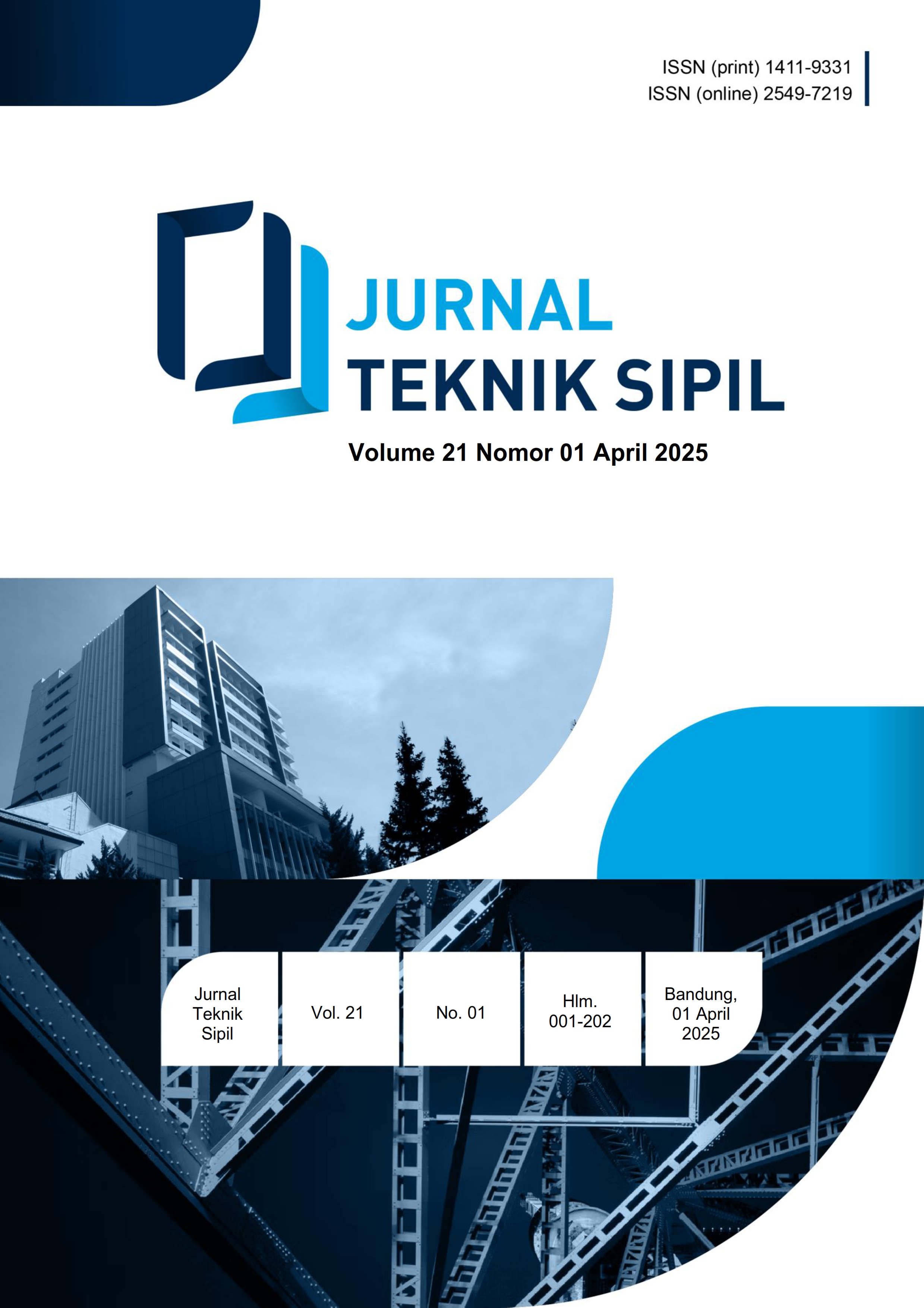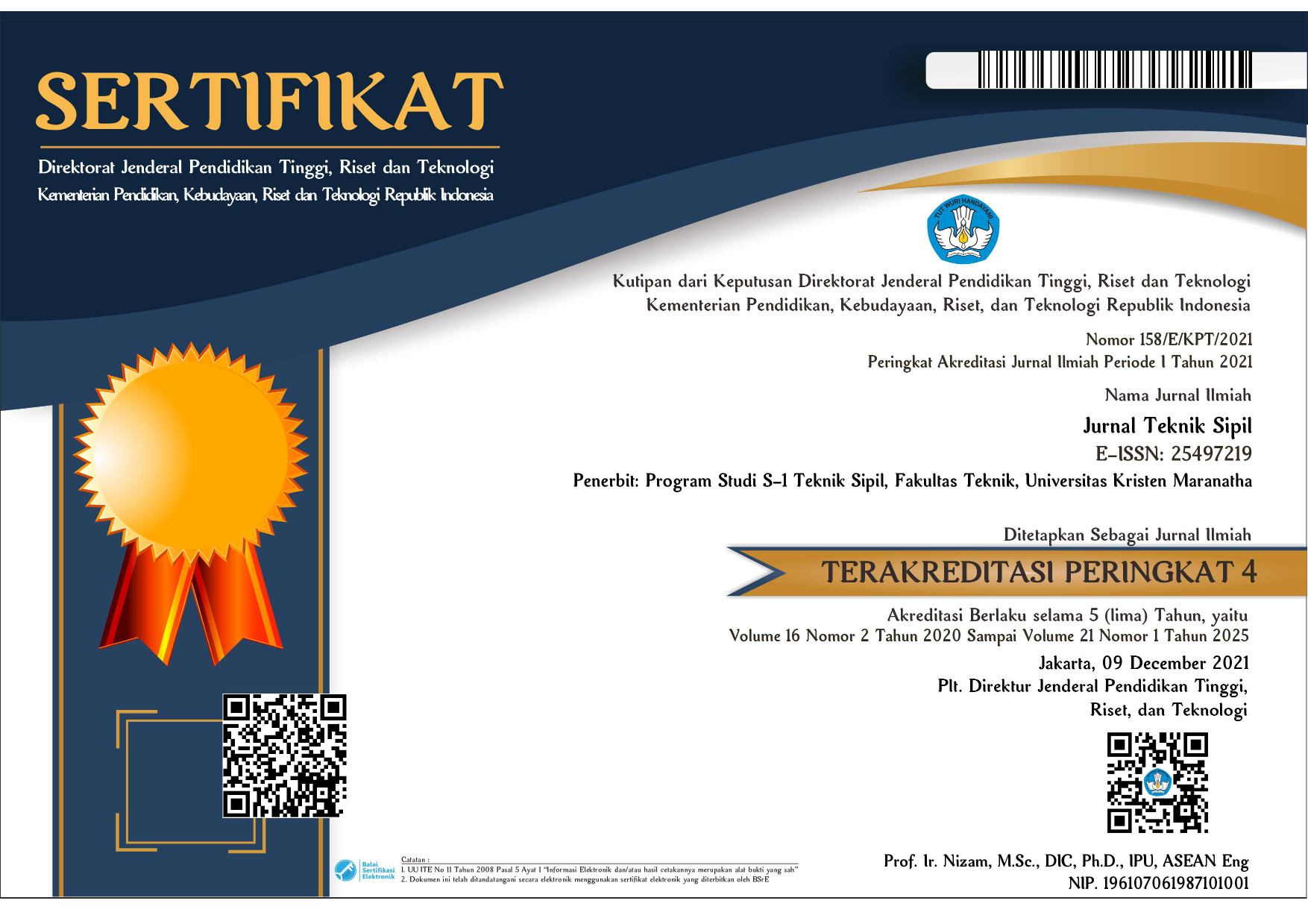Karakteristik Parameter Kuat Geser Tanah pada Lereng Akibat Perubahan Kadar Air Tanah
DOI:
https://doi.org/10.28932/jts.v21i1.7509Kata Kunci:
Direct Shear, Kohesi, Longsoran, Sudut Geser DalamAbstrak
Longsoran yang terjadi pada lereng diindikasikan disebabkan oleh peningkatan massa tanah akibat bertambahnya kadar air yang mengisi pori-pori tanah yang akan memengaruhi sifat-sifat tanah terutama kuat geser sebagai salah satu sifat mekanis tanah. Penelitian ini bertujuan untuk menganalisis pengaruh perubahan kadar air tanah terhadap kuat geser tanah pada lereng. Penelitian menggunakan sampel tanah terganggu yang diambil pada pinggiran lereng di Ruas Jalan Manna-Pagaralam dan telah dikeringkan. Pengujian pemadatan dilakukan untuk mendapatkan nilai kadar air optimum (OWC) yang akan merepresentasikan nilai tengah dari variasi kadar air tanah pada sampel uji. Variasi sampel uji di antaranya OWC-20%OWC, OWC-10%OWC, OWC, OWC+10%OMC, dan OWC+20%OWC. Kuat geser tanah didapatkan dengan pengujian Direct Shear. Menurut standar USCS tanah diklasifikasikan sebagai tanah lempung berpasir. Hasil pengujian Direct shear didapatkan nilai kohesi (c) tertinggi pada variasi OWC atau pada variasi kadar air optimum yaitu 2,796 kPa. Hal ini dikarenakan nilai kohesi terjadi pada bagian butiran halus yaitu lempung yang dipengaruhi oleh kandungan air antar butiran. Sedangkan nilai sudut geser dalam tertinggi didapatkan pada variasi OWC-10%OWC sebesar 32,15o hal ini dikarenakan nilai sudut geser dalam terjadi pada bagian butiran kasar yaitu butiran pasir dimana gesekan akan berkurang seiring dengan bertambahnya kandungan air yang mengisi pori-pori tanah.Unduhan
Referensi
A.R. Estabragh, B. P. (2015). Laboratory investigation of the effect of cyclic wetting and drying on the behaviour of an expansive soil. Soils and Foundations, 55(2), 304-314.
Achmad Hafidz, M. F. (2019, April). Analisis Perubahan Faktor Keamanan Lereng Akibat Hujan. Jurnal Teknik Sipil dan Lingkungan, 4(1), 1-8.
Andrian, S. P. (2014). Pengaruh Ketinggian Tempat Dan Kemiringan Lereng Terhadap Produksi Karet (Hevea brasiliensis Muell. Arg.) di Kebun Hapesong Ptpn Iii Tapanuli Selatan. Jurnal Online Agroekoteknologi, 2(3), 981-989.
ASTM. (2003). Annual Book of ASTM Standard (Vol. 4).
Bowles, J. E. (1984). Sifat-sifat Fisis dan Geoteknis Tanah. Jakarta: Erlangga.
Dafalla, M. A. (2013). Effects of Clay and Moisture Content on Direct Shear Tests for Clay-Sand Mixtures. Advance in Materials Science and Engineering.
Daniel Tjandra, I. R. (2015). Effect of Drying-Wetting Process on Frcition Capacity and Adhesion Factor of Pile Foundation in Clayey Soil. Jurnal Teknologi (Science and Engineering), 77(11), 145-150.
Hardiyatmo, H. C. (2010). Mekanika Tanah II. Yogyakarta: Gadjah Mada University Press.
Hasrullah. (2012). Studi Pengaruh Infiltrasi Terhadap Stabilisasi Lereng. Jurnal Ilmu Teknik, 5, 1-13.
Hesti Subiyanti, A. R. (2011). Analisis Pengaruh Tekanan air Pori di Kelongsoran Lereng Akibat Saluran Induk Kalibawang Kulonprogo. Jurnal Ilmiah Semesta, 14(1), 15-25.
Hossain Md. Sayem, L. W. (2016). Effects of drying-wetting cycles on saturated shear strength. American Journal of Civil Engineering, 4(4), 159-166.
Jie Yin, k. Z. (2021). ffect of Initial Water Content on Undrained Shear Strength of Ko Consolidated Clay. Soils and Foundation, 61, 1453-1453.
Qiang Liu, P. X. (2020, August). Qiang Liu, P. X. (2020, August). Applicability of Wetting Front Advancing Method in The Sand to Silty Clay Soils. Soils and Foundation, 60, 1215-1225. Soils and Foundation, 60, 1215-1225.
Wilham G. Loushenapessy, B. L. (2022, Oktober). Analyzing The Effect of Water Seepage and Scour on Slope Stability Using Finite Element Method. Jurnal Teknik Sipil, 18(2), 216-229.
Xu tang Xu, L. j. (2021). Effect of wet-dry cycles on shear strength of residual soil. Soils and Foundation, 61, 782-797.
##submission.downloads##
Diterbitkan
Cara Mengutip
Terbitan
Bagian
Lisensi
Hak Cipta (c) 2024 Ghina Amalia, Utari Sriwijaya Minaka, Aprilianda Aprilianda

Artikel ini berlisensi Creative Commons Attribution-NonCommercial 4.0 International License.
























